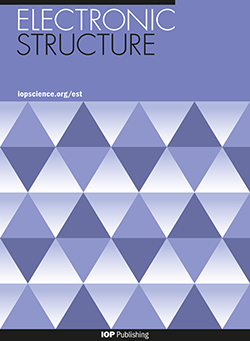About Electronic Structure
Scope
Electronic Structure™ is a multidisciplinary journal covering all theoretical and experimental aspects of electronic structure research, including the development of new methods. It is dedicated to the entirety of electronic structure research and its community, spanning materials science, physics, chemistry and biology. We welcome papers using any theoretical or experimental technique to study any aspect of electronic structure.
Why publish in Electronic Structure?
- High standards: rigorous peer review from IOP Publishing’s global network of expert reviewers, with high-quality online production of published work and the support of a top-level editorial board.
- Fast publication: we are committed to providing you with a fast, professional service to ensure rapid first decision, acceptance and publication. Once accepted, your article will be accessible to readers within 24 hours and will include a citable DOI.
- Open access: compliant with all major funding bodies’ requirements.
- Transfer opportunities: as well as accepting direct submissions, the journal also offers you a quick and easy solution to transfer your manuscript from another IOP Publishing journal if it does not fit that journal’s scope or significance criteria. Articles are transferred along with peer review reports to save time and avoid duplication of work for reviewers.
- International Editorial Board: led by founding Editors-in-Chief Bert de Jong and Risto Nieminen.
- Society owned: Any profits generated by IOP Publishing are used by the Institute of Physics to support science and scientists in both the developed and developing world.
Article types
Electronic Structure welcomes submissions of the following article types:
- Research Papers: report original research work; normally not more than 8500 words.
- Topical Reviews: present a snapshot of recent progress in a particular field. They may contain a mixture of review and original material. They are usually commissioned by the Editorial Board but submitted reviews will also be considered. They should typically be between 10 000 and 15 000 words in length.
- Technical Notes: should demonstrate a new computational or experimental methodology, or an improvement to existing methods, with proof of application. They do not need to demonstrate a scientific advance but must still advance technical knowledge.
- Focus Issue Articles: research papers published as part of a guest-edited collection centred around an emerging and highly topical field.
- Roadmaps: broad, multi-author reviews with leaders in the field discussing the latest developments. Commissioned by the Editorial Board.
Peer review
The following summary describes the peer review process for Electronic Structure, using the ANSI/NISO Standard Terminology for Peer Review:
- Identity transparency: single-anonymous, double-anonymous (author choice)
- Reviewer interacts with: Editor
- Review information published: review reports (author and reviewer opt in), author/editor communication, reviewer identities (reviewer opt in)
Our Publishing Support website provides more information on our reviewing process as well as checklists in both English and Chinese language to help authors prepare their manuscripts for submission.
If an article is not accepted for publication, we may offer the author the opportunity to transfer their submission to other suitable journals we publish.
Inclusivity and diversity
IOP Publishing recognises that there are inequalities within the scientific publishing and research ecosystems. We are committed to a progressive approach to inclusivity and diversity, and are working hard to eliminate discrimination to foster an equitable and welcoming publishing environment for all.
IOP Publishing follows Guidelines on Inclusive Language and Images in Scholarly Communication to ensure that journal articles use bias-free and culturally sensitive communication. We ask authors to please follow these guidelines in their manuscript submissions.
More information about our work on inclusivity is available on our Open Physics hub.
Ethics
Research data
Please note that this policy requires authors to include a data availability statement in their article.
For any questions about the policy please contact the journal.
Many research funders now require authors to make all data related to their research available in an online repository. Please refer to the policy for further information about research data, data repositories and data citation.
Open access
Alternatively authors who do not select the gold open access option can choose a green open access route to publication.
For more information on IOP Publishing’s open access policies please see our Open access page. For our author rights policies please see our Author rights page.
Publication charges
Publication on a subscription-access basis is free of charge.
Authors have the option to pay the following article publication charge (APC) to publish their article on an open access basis under a Creative Commons Attribution (CC BY) licence.
| GBP | EUR | USD | |
| Article publication charge* | £2410 | €2765 | $3325 |
| Reduced article publication charge* for Group B countries** | £500 | €575 | $675 |
| Reduced article publication charge for Group A countries** | £0 | €0 | $0 |
*excluding VAT where applicable
**eligibility criteria can be found here
APCs only apply to articles accepted for publication; there are no submission charges.
There are no other charges for publishing in Electronic Structure.
Transformative Agreements
Electronic Structure is included in our transformative agreements which allow authors from some institutions to publish open access without paying an APC.Find out if you’re covered by an agreement
If you are covered by an agreement, use our author guide to help you submit your paper.
Paying for open access
Various discounts, waivers and funding arrangements are available to support our authors. Visit our Paying for open access page for further details.
Abstracting and indexing services
We work with our authors to help make their work as easy to discover as possible. Electronic Structure is currently included in the following abstracting and discovery services:
- Web of Science (Emerging Sources Citation Index)
- Chemical Abstracts Service
- CNKI
- Ei Compendex
- Inspec
- J-Gate
- JST
- Nasa Astrophysics Data System
- Naver Academic
Electronic Structure has recently been accepted by Scopus and indexing will begin shortly.
